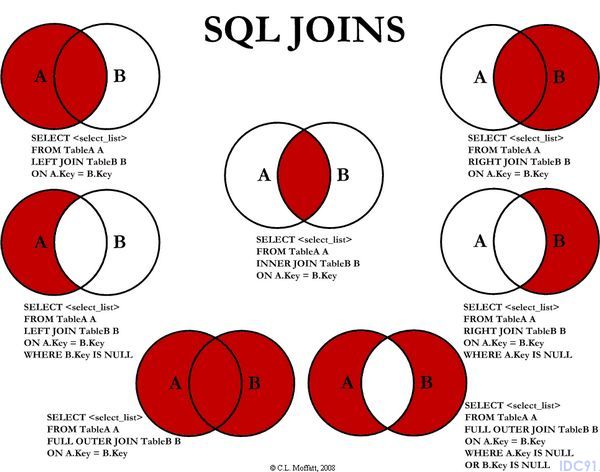SQL之各种join小结详细讲解
SQL Left Join, Right Join, Inner Join, and Natural Join 各种Join小结
在SQL语言中,存在着各种Join,有Left Join, Right Join, Inner Join, and Natural Join等,对于初学者来说肯定一头雾水,都是神马跟神马啊,它们之间到底有着怎样的区别和联系呢,我们先用一张图片来说明:

上面这张图很好的阐释了Left Join, Right Join, Inner Join,和Full Outer Join的区别,下面用我们用一个简单的例子来帮助我们理解和区分,现在有两个表Person和Address:
-- Table Person
+----------+-----------+----------+
| PersonId | FirstName | LastName |
+----------+-----------+----------+
| 1 | Zhang | San |
| 2 | Li | Si |
| 3 | Wang | Wu |
| 4 | Yang | Liu |
+----------+-----------+----------+
-- Table Address
+-----------+----------+---------------+-------+
| AddressId | PersonId | City | State |
+-----------+----------+---------------+-------+
| 1 | 2 | San Francisco | CA |
| 2 | 3 | Los Angeles | CA |
| 3 | 1 | San Diego | CA |
+-----------+----------+---------------+-------+
我们下面一个一个的来看:
Left Join: returns all rows from the left table (table1), with the matching rows in the right table (table2). The result is NULL in the right side when there is no match.
左交:返回左表的所有行和匹配的右表的行,如果没有匹配上的用NULL.
SELECT * FROM Person LEFT JOIN Address ON Person.PersonId = Address.PersonId;
+----------+-----------+----------+-----------+----------+---------------+-------+
| PersonId | FirstName | LastName | AddressId | PersonId | City | State |
+----------+-----------+----------+-----------+----------+---------------+-------+
| 2 | Li | Si | 1 | 2 | San Francisco | CA |
| 3 | Wang | Wu | 2 | 3 | Los Angeles | CA |
| 1 | Zhang | San | 3 | 1 | San Diego | CA |
| 4 | Yang | Liu | NULL | NULL | NULL | NULL |
+----------+-----------+----------+-----------+----------+---------------+-------+
Right Join: returns all rows from the right table (table2), with the matching rows in the left table (table1). The result is NULL in the left side when there is no match.
右交:返回右表的所有行和匹配的左表的行,如果没有匹配上的用NULL.
SELECT * FROM Person RIGHT JOIN Address ON Person.PersonId = Address.PersonId;
+----------+-----------+----------+-----------+----------+---------------+-------+
| PersonId | FirstName | LastName | AddressId | PersonId | City | State |
+----------+-----------+----------+-----------+----------+---------------+-------+
| 1 | Zhang | San | 3 | 1 | San Diego | CA |
| 2 | Li | Si | 1 | 2 | San Francisco | CA |
| 3 | Wang | Wu | 2 | 3 | Los Angeles | CA |
| NULL | NULL | NULL | 4 | 5 | Memphis | TN |
+----------+-----------+----------+-----------+----------+---------------+-------+
Inner Join: selects all rows from both tables as long as there is a match between the columns in both tables.
内交: 选择左右表中关键字匹配上的行。
SELECT * FROM Person INNER JOIN Address ON Person.PersonId = Address.PersonId; +----------+-----------+----------+-----------+----------+---------------+-------+
| PersonId | FirstName | LastName | AddressId | PersonId | City | State |
+----------+-----------+----------+-----------+----------+---------------+-------+
| 1 | Zhang | San | 3 | 1 | San Diego | CA |
| 2 | Li | Si | 1 | 2 | San Francisco | CA |
| 3 | Wang | Wu | 2 | 3 | Los Angeles | CA |
+----------+-----------+----------+-----------+----------+---------------+-------+
Full Join: returns all rows from the left table (table1) and from the right table (table2), and it combines the result of both LEFT and RIGHT joins.
全交: 返回左表的所有行和右表的所有行,是左交和右交的联合。
注意,由于MySql中没有Full Join命令,所以我们通过把Left Join和Right Join的结果Union起来也是可以的:
SELECT * FROM Person LEFT JOIN Address ON Person.PersonId = Address.PersonId UNION
SELECT * FROM Person RIGHT JOIN Address ON Person.PersonId = Address.PersonId; +----------+-----------+----------+-----------+----------+---------------+-------+
| PersonId | FirstName | LastName | AddressId | PersonId | City | State |
+----------+-----------+----------+-----------+----------+---------------+-------+
| 2 | Li | Si | 1 | 2 | San Francisco | CA |
| 3 | Wang | Wu | 2 | 3 | Los Angeles | CA |
| 1 | Zhang | San | 3 | 1 | San Diego | CA |
| 4 | Yang | Liu | NULL | NULL | NULL | NULL |
| NULL | NULL | NULL | 4 | 5 | Memphis | TN |
+----------+-----------+----------+-----------+----------+---------------+-------+
Natural Join: creates an implicit join clause for you based on the common columns in the two tables being joined. Common columns are columns that have the same name in both tables. A NATURAL JOIN can be an INNER join, a LEFT OUTER join, or a RIGHT OUTER join. The default is INNER join.
自然交: 根据左右两表的相同列创建一个隐含的join操作,相同列就是两表中列名相同的两列。自然交可以是内交,左交或者是右交。默认是内交。
SELECT * FROM Person NATURAL JOIN Address;
+----------+-----------+----------+-----------+---------------+-------+
| PersonId | FirstName | LastName | AddressId | City | State |
+----------+-----------+----------+-----------+---------------+-------+
| 1 | Zhang | San | 3 | San Diego | CA |
| 2 | Li | Si | 1 | San Francisco | CA |
| 3 | Wang | Wu | 2 | Los Angeles | CA |
+----------+-----------+----------+-----------+---------------+-------+
最后注意一下,下面等号左右两边的关键字是等价的:
A LEFT JOIN B = A LEFT OUTER JOIN B A RIGHT JOIN B = A RIGHT OUTER JOIN B A FULL JOIN B = A FULL OUTER JOIN B A INNER JOIN B = A JOIN B
您可能感兴趣的文章
- 05-31MySQL中的 inner join 和 left join的区别解析(小结果集驱动大结果集)
- 05-31MySQL索引失效十种场景与优化方案
- 05-31MYSQL 高级文本查询之regexp_like和REGEXP详解
- 05-31MySQL获取binlog的开始时间和结束时间(最新方法)
- 05-31MySQL索引查询的具体使用
- 05-31基于MySQL和Redis扣减库存的实践
- 05-31关于MySQL的存储过程与存储函数
- 05-31MySQL实战文章(非常全的基础入门类教程)
- 05-31MySQL Flink Watermark实现事件时间处理的关键技术
- 05-31MySQL Flink实时流处理的核心技术之窗口机制


阅读排行
推荐教程
- 05-30开启MySQL远程连接的方法
- 05-30MySQL数据库中varchar类型的数字比较大小的方法
- 05-30浅谈mysql返回Boolean类型的几种情况
- 05-30MySQL线上死锁分析实战
- 05-30Prometheus 监控MySQL使用grafana展示
- 05-30CentOS7安装MySQL 8.0.26的过程
- 05-30Navicat for MySQL 11注册码激活码汇总
- 05-30详解mysql触发器trigger实例
- 05-30MySQL高可用架构之MHA架构全解
- 05-30mysql 8.0.24 安装配置方法图文教程


